Steel Products Prices North America

Flat Roll Imports Jump in May-July
Written by Peter Wright
August 2, 2017
Total imports of rolled steel increased by 16.9 percent, and sheet products by 18.4 percent, in the three months through July, compared with the prior three months, according to final license data for July released by the U.S. Commerce Department on Aug. 1. The three-month moving average (3MMA) of the total volume of rolled product imports in July was the highest since May 2015. (See the note at this end of this piece on SMU’s methodology and the data from the Steel Import Monitoring and Analysis system. All volumes are reported in short tons.)
The July increase in imports was all in flat roll. Semis and long products declined. Total rolled product licensed imports in the single month of July were 2,685,458 tons with a 3MMA of 2,677,691 tons. We prefer not to dwell on single-month results because of the extreme variability that can occur in individual products. In the comments below, we use three-month moving averages to give what we believe is the most accurate picture.
Figure 1 shows the 3MMA through July licensed tons of semi-finished, flat and long products since January 2004. Imports of semi-finished in July had a 3MMA of 787,117 tons, which was up by 12.2 percent year over year. “Flat” includes all hot and cold rolled sheet and strip, plus all coated sheet products, plus both discrete and coiled plate. The 3MMA of flat rolled imports was 1,262,785 tons in July, which was the most since September 2015. Long product imports have been range bound between 519,000 tons and 772,000 tons since July 2014 with no trend evident. In July 2017, the 3MMA of long product imports was 628,305 tons.
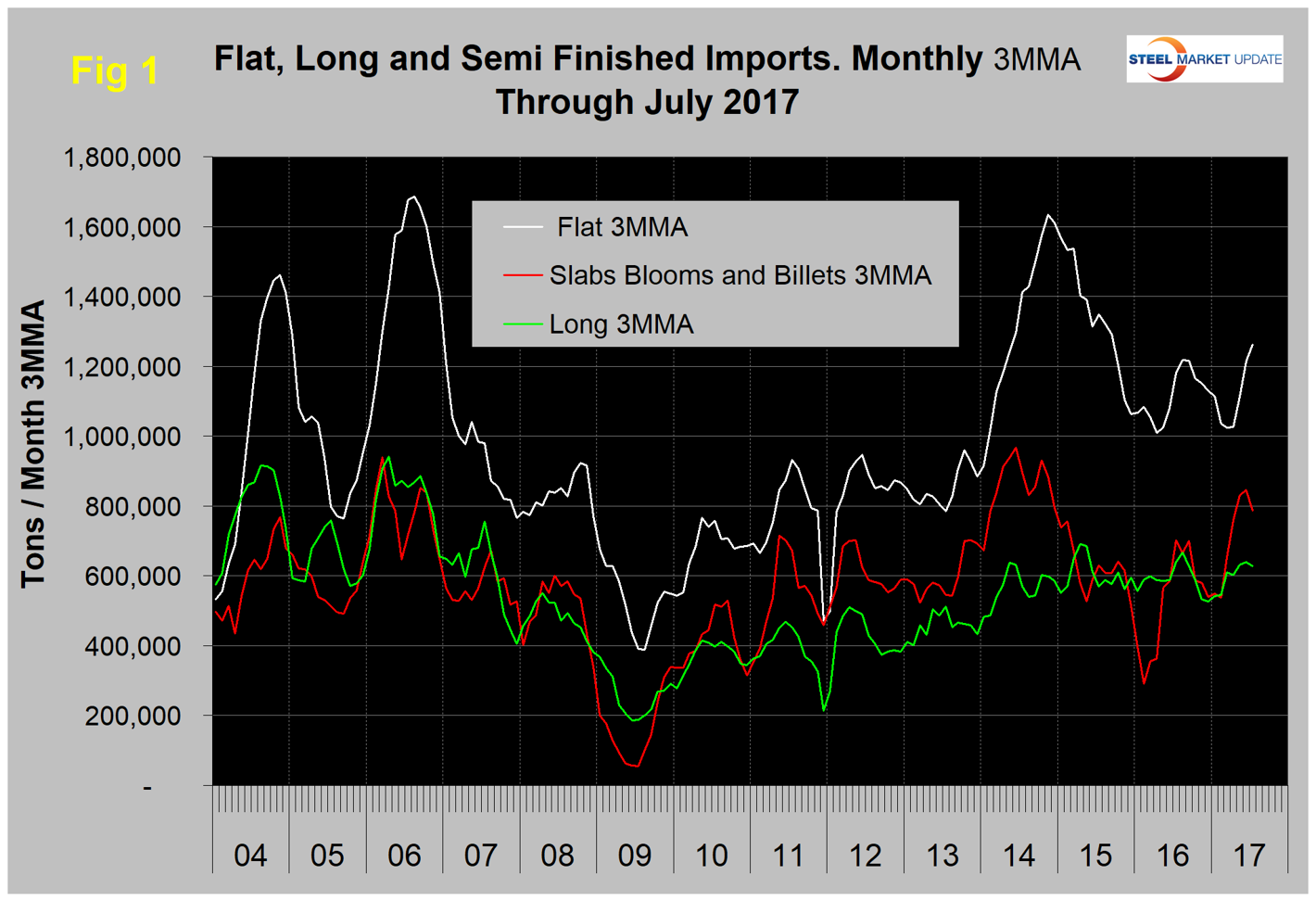
Figure 2 shows the 3MMA trend of sheet and strip imports since January 2004. The total of these products increased by 18.4 percent in three months through July, compared to three months through April, and was up by 10.7 percent year over year. HRC imports declined sharply in the five months through February, but have increased since then. CRC and HDG are now higher than HRC on a 3MMA basis, which is very unusual. Imports of other metallic coated (OMC), mainly Galvalume and tin plate, have been trending up since 2009 and had a very sharp increase in July. Electrogalvanized is the only sheet product in which exports exceed imports.
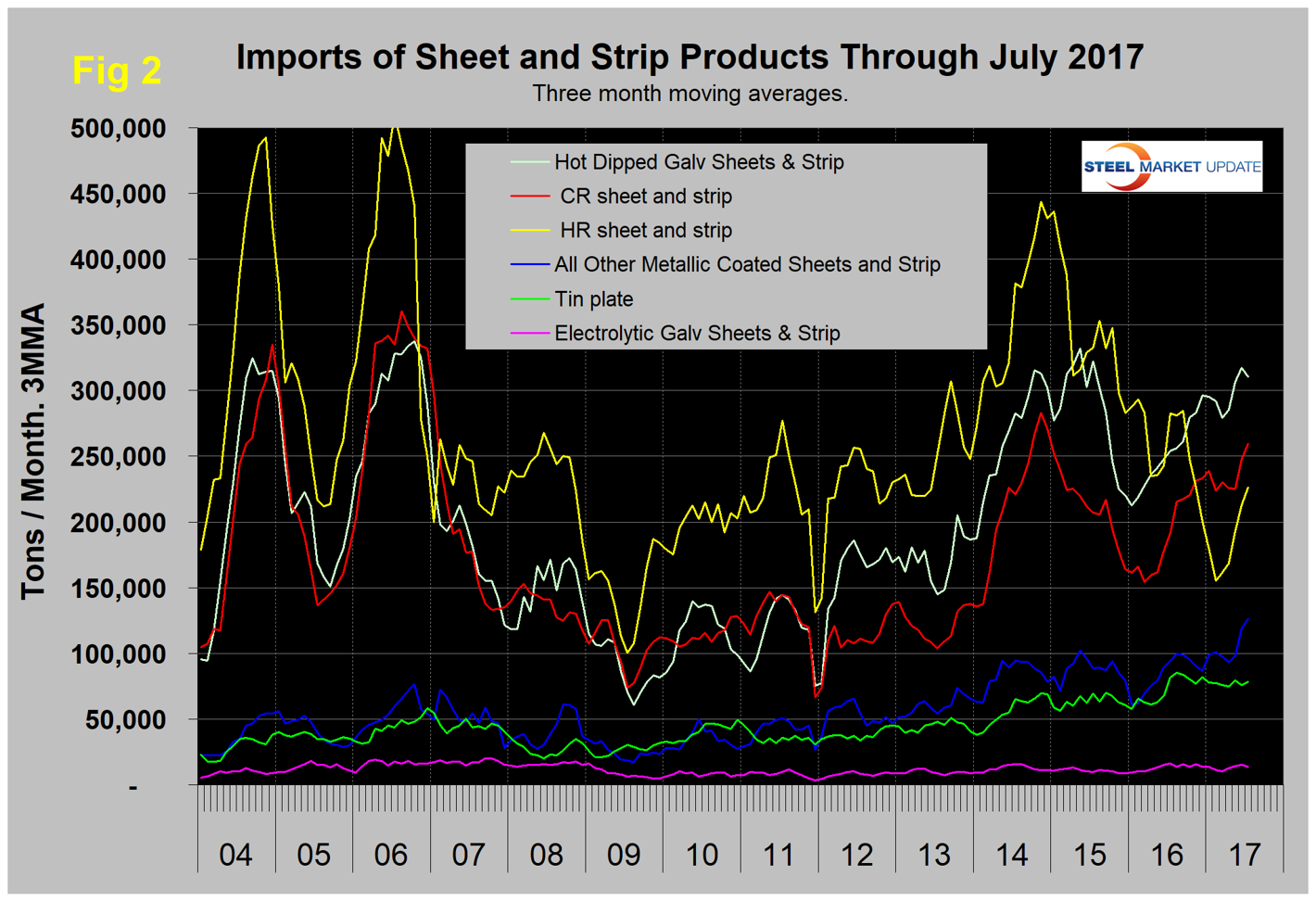
Table 1 provides an analysis of major product groups and of sheet products in detail. It compares the average monthly import tonnage in the three months through July 2017 with both three months through April (3M/3M) and the three months through July 2016 (Y/Y). All product groups were up in the three-month time comparison. Plate was up by the most with a 53.2 percent increase. Discrete plate was up by 60 percent and coiled by 54 percent. Only HRC, tin plate and electrogalvanized had any relief compared to the year-ago results. The total of all rolled product imports was up by 22.3 percent Y/Y. Total sheet products were up by 10.7 percent. Tubulars were up by 120.4 percent and long products were down by 1.7 percent.
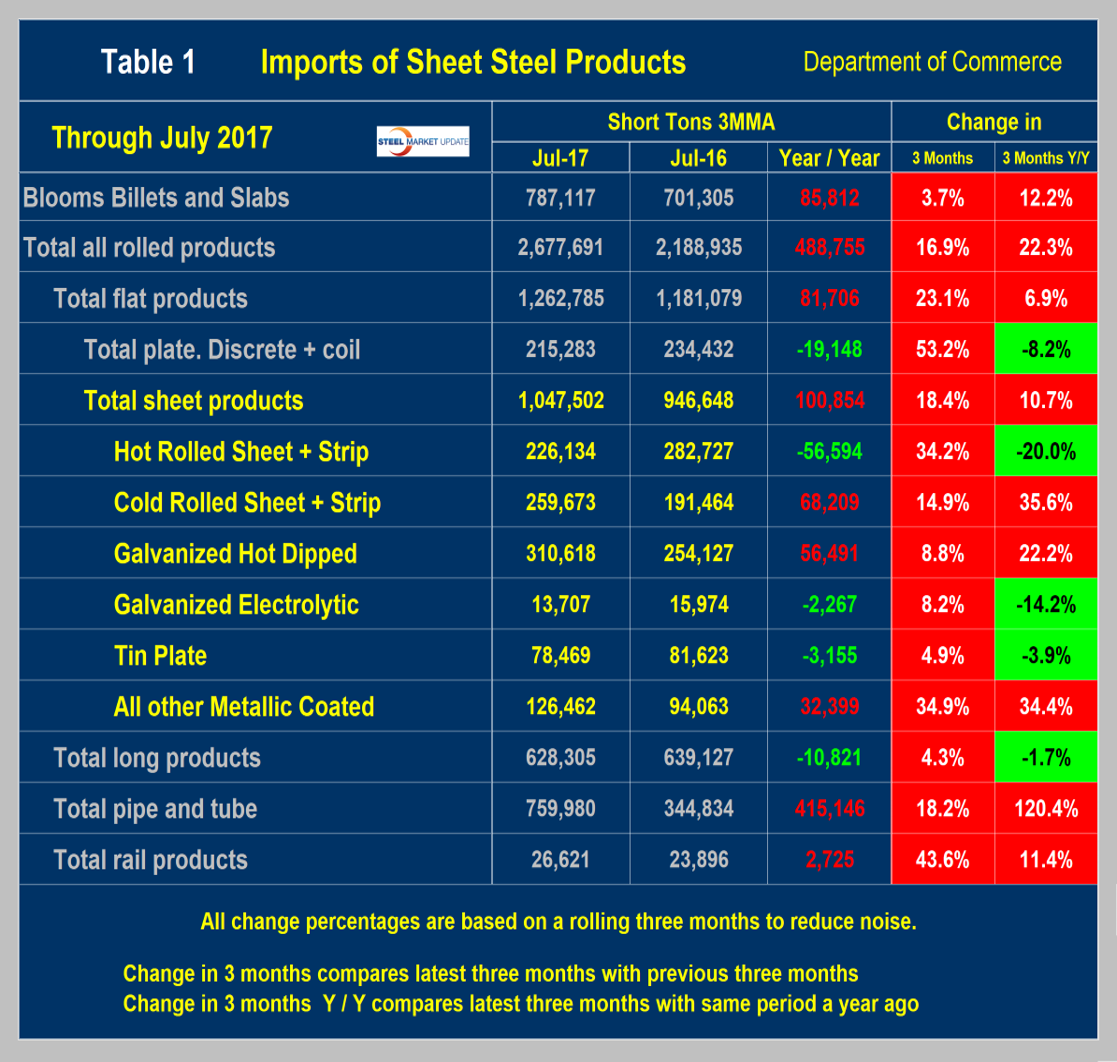
Imports of individual sheet products showed big differences compared to last year. HRC was down by 20.0 percent Y/Y, CRC and HDG were up by 35.6 percent and 22.2 percent, respectively. OMC was up by 34.4 percent. Table 2 shows the same analysis for long products. The total tonnage of long product imports was down by 10,821 tons per month Y/Y. On a 3M/3M basis, the total volume of long product imports increased by 4.3 percent.
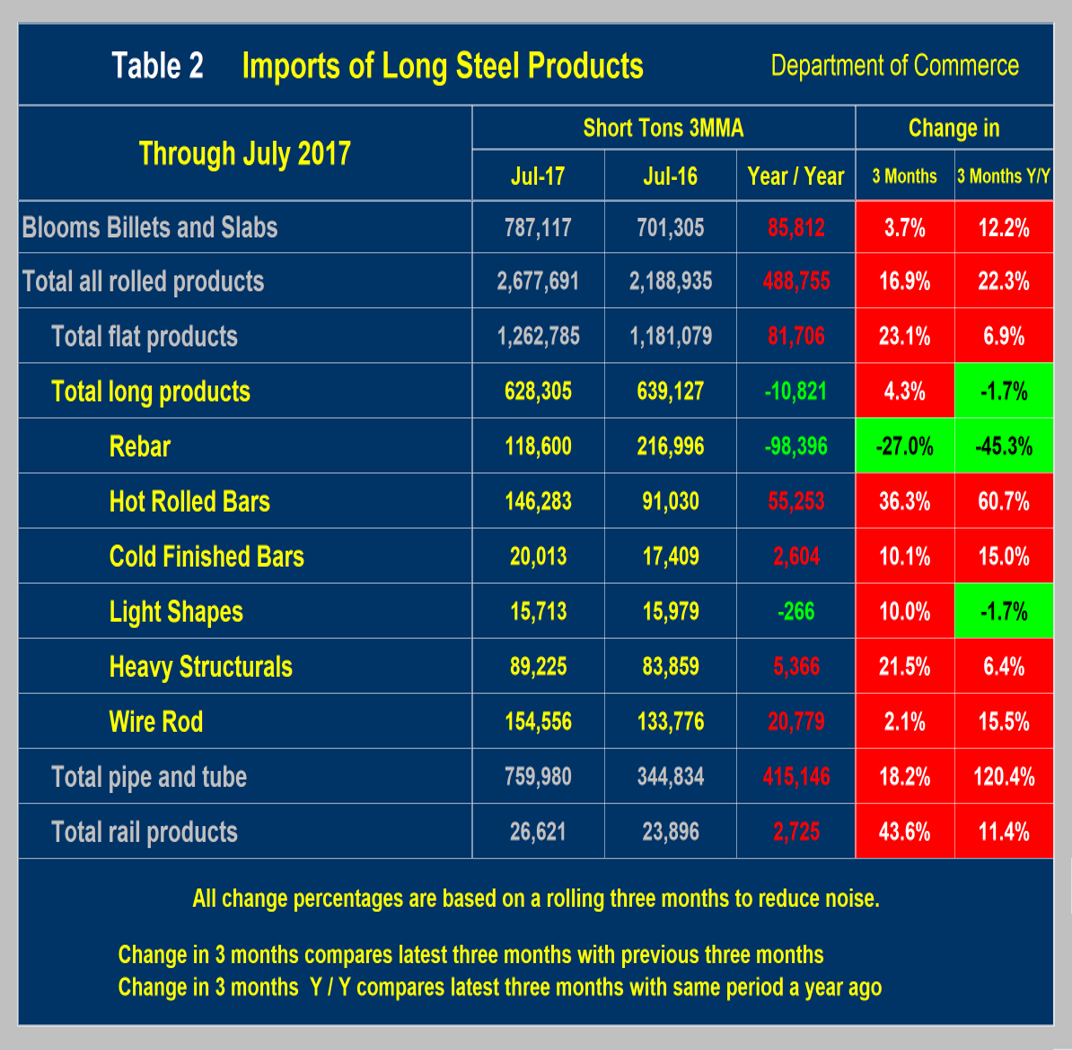
Figure 3 shows the import market share of sheet and long products through May, which is the latest data available. The import market share of sheet products peaked at 24.3 percent in March 2015. The May 2017 level was 19.6 percent. Long product import market share has been considerably higher than for sheet products since early 2015 and in May was 28.1 percent.
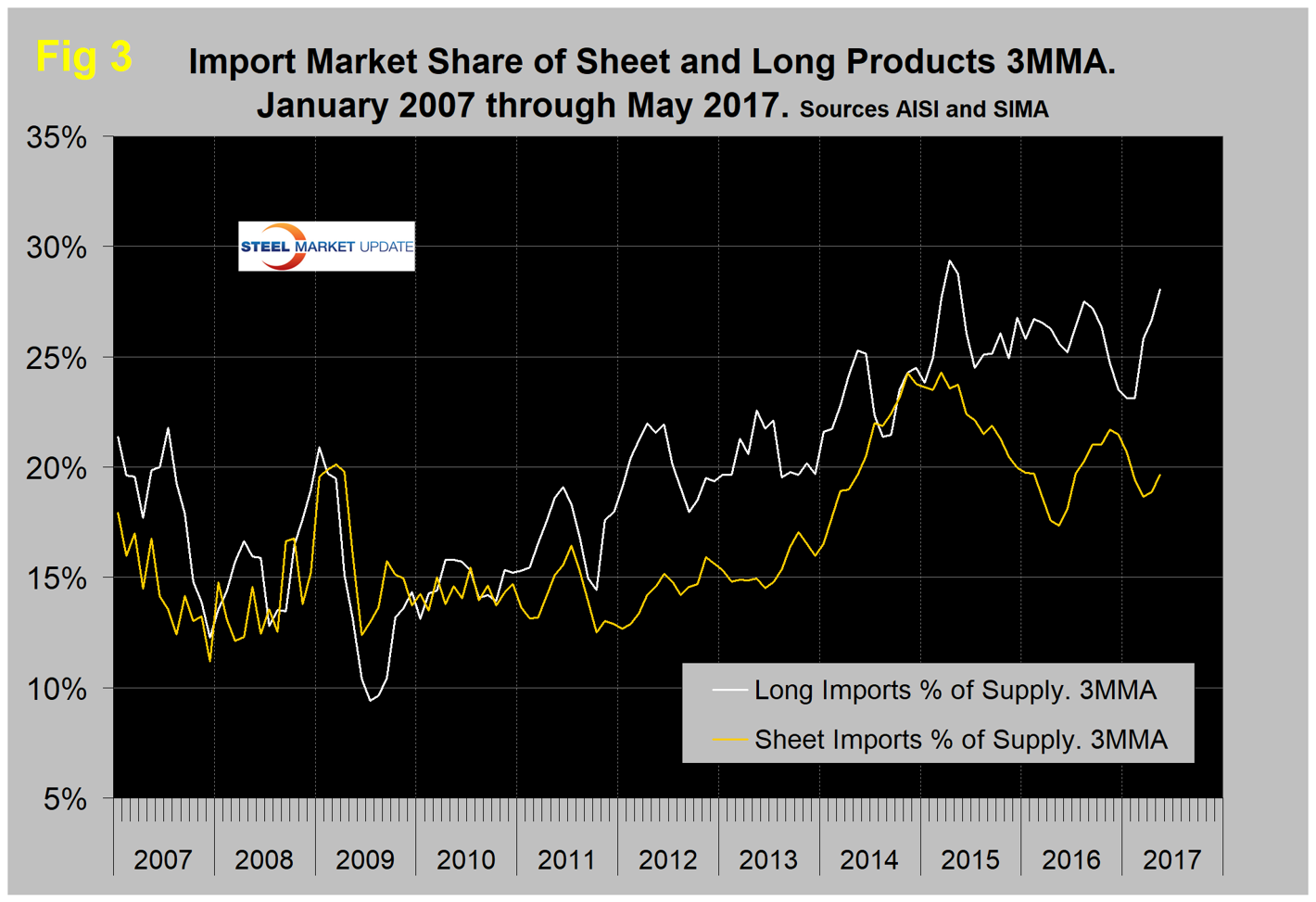
Figures 4 through 7 show domestic mill shipments to domestic locations, imports and import market share for the four major sheet products. Note that the righthand import share axes are the same to give true comparability. HRC has the lowest import share, CRC and HDG are similar and OMC is by far the highest.
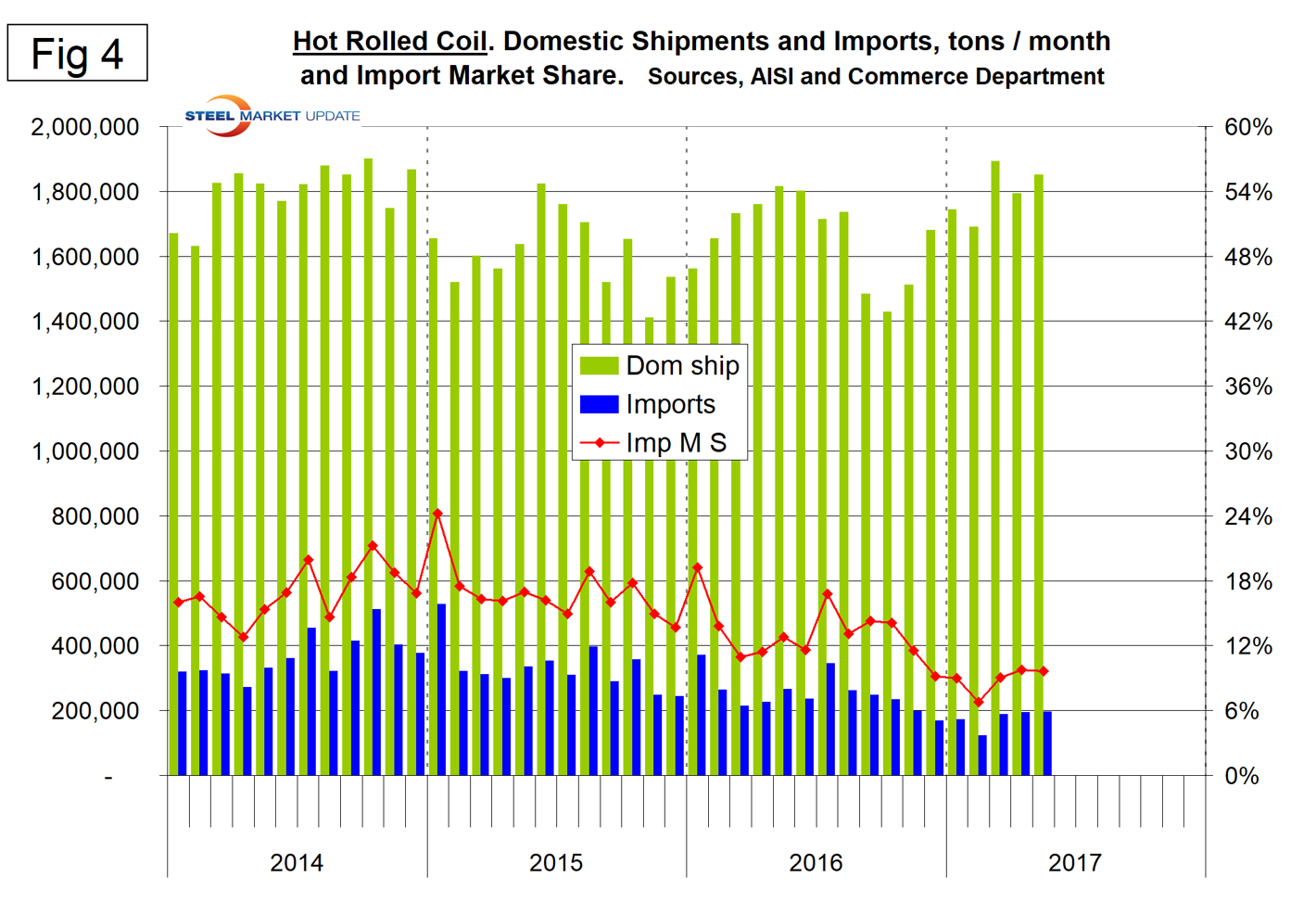
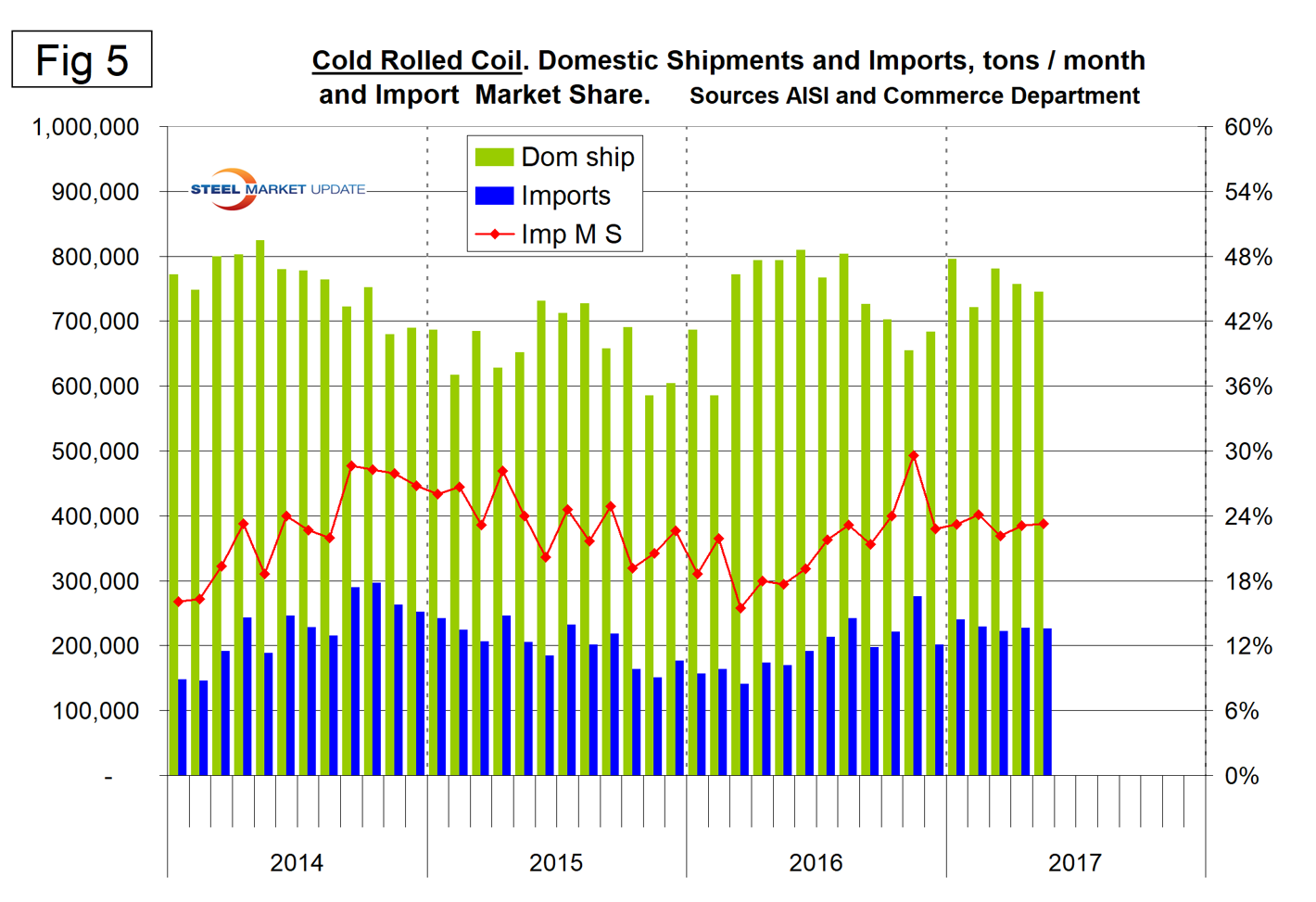
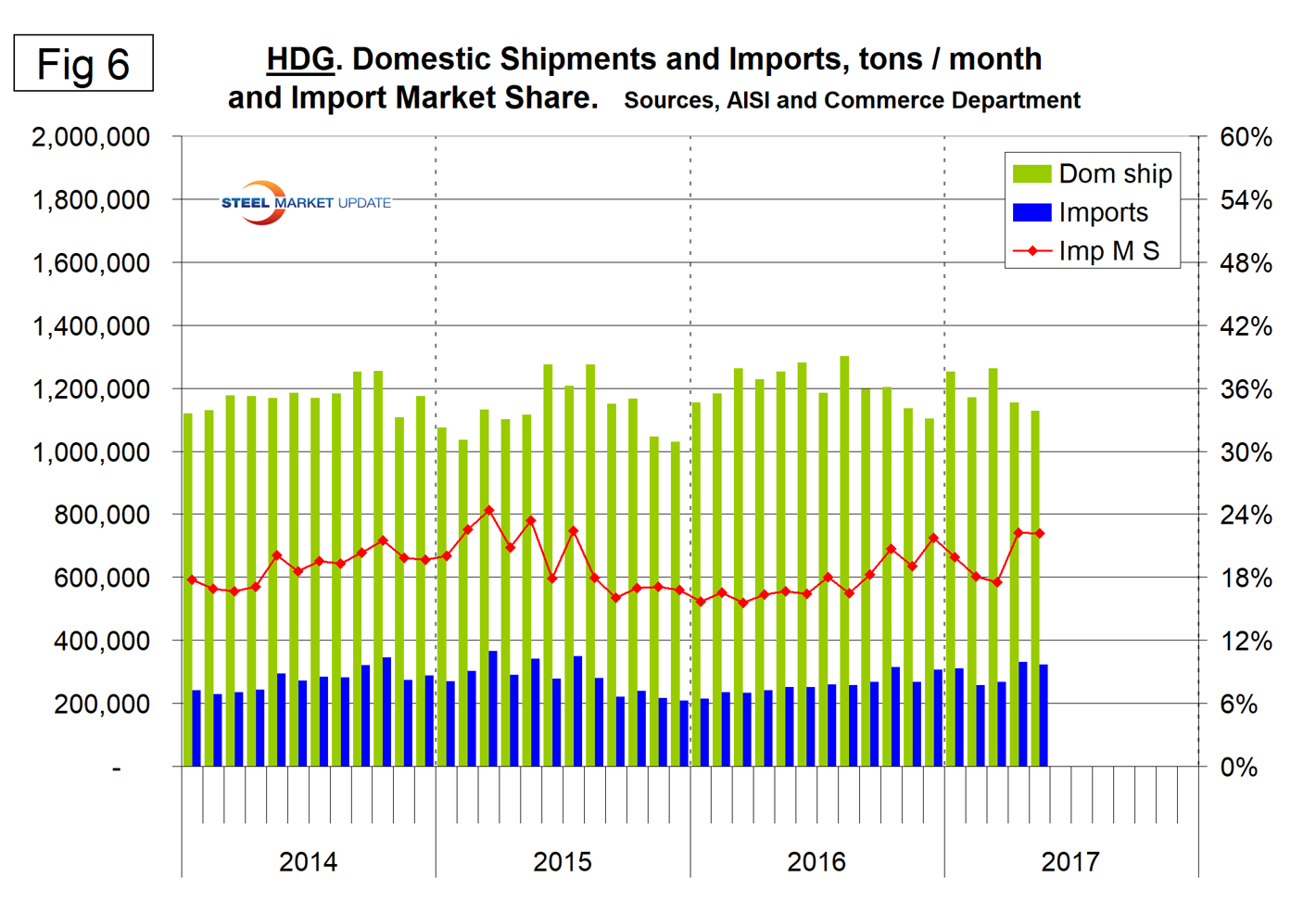
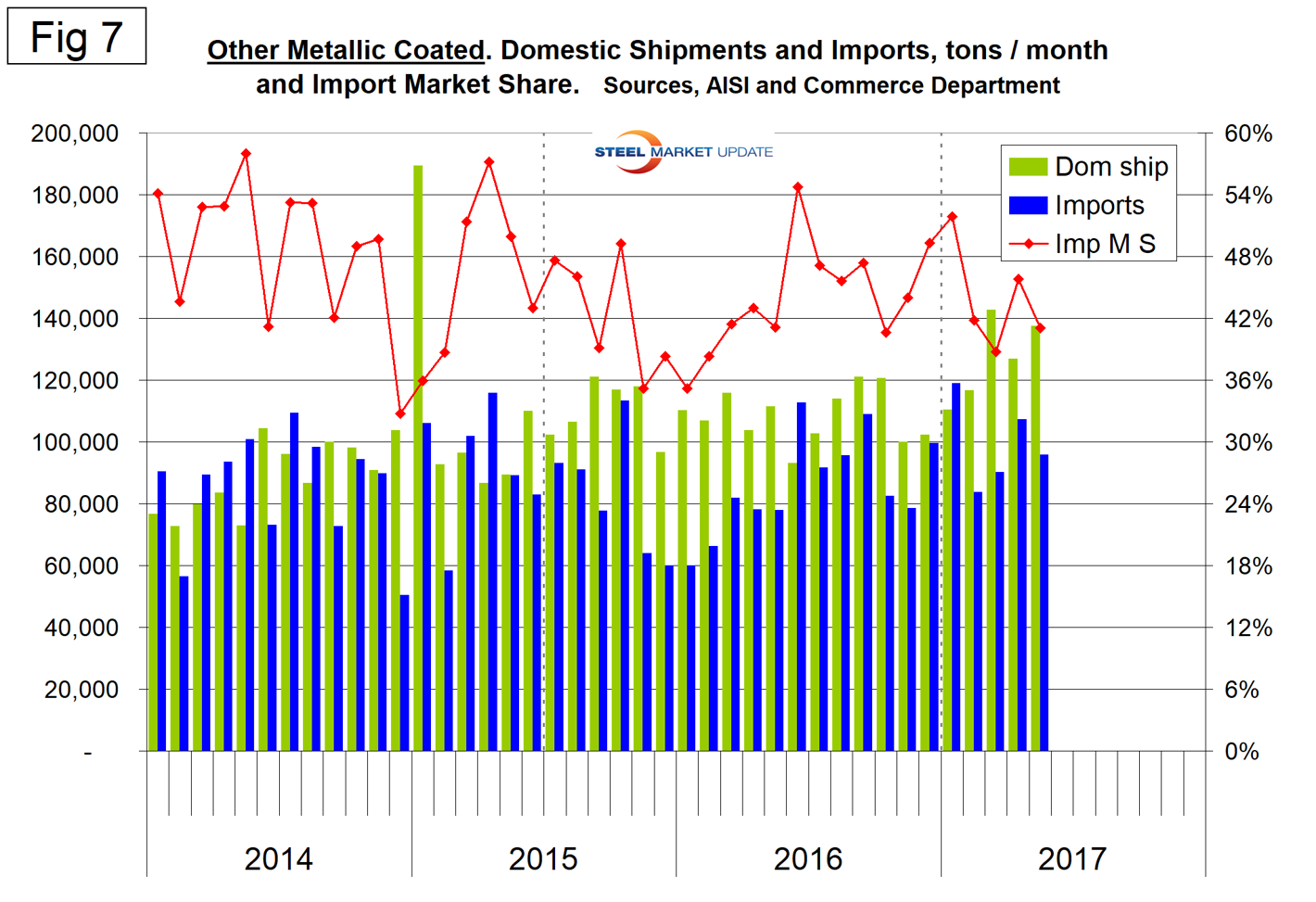
Net imports equals imports minus exports. Our analysis is based on the final volumes through May. We regard this as an important look at the overall trade picture and its effect on demand at the mill level. Figure 8 shows net sheet product imports on a 3MMA basis to be 543,334 tons in May, which was close to the February through April levels but down from 665,083 in August last year. Exports have increased every month this year driven by the depreciation of the U.S. dollar on the international foreign exchange markets. Net sheet steel imports are still high by historical standards.
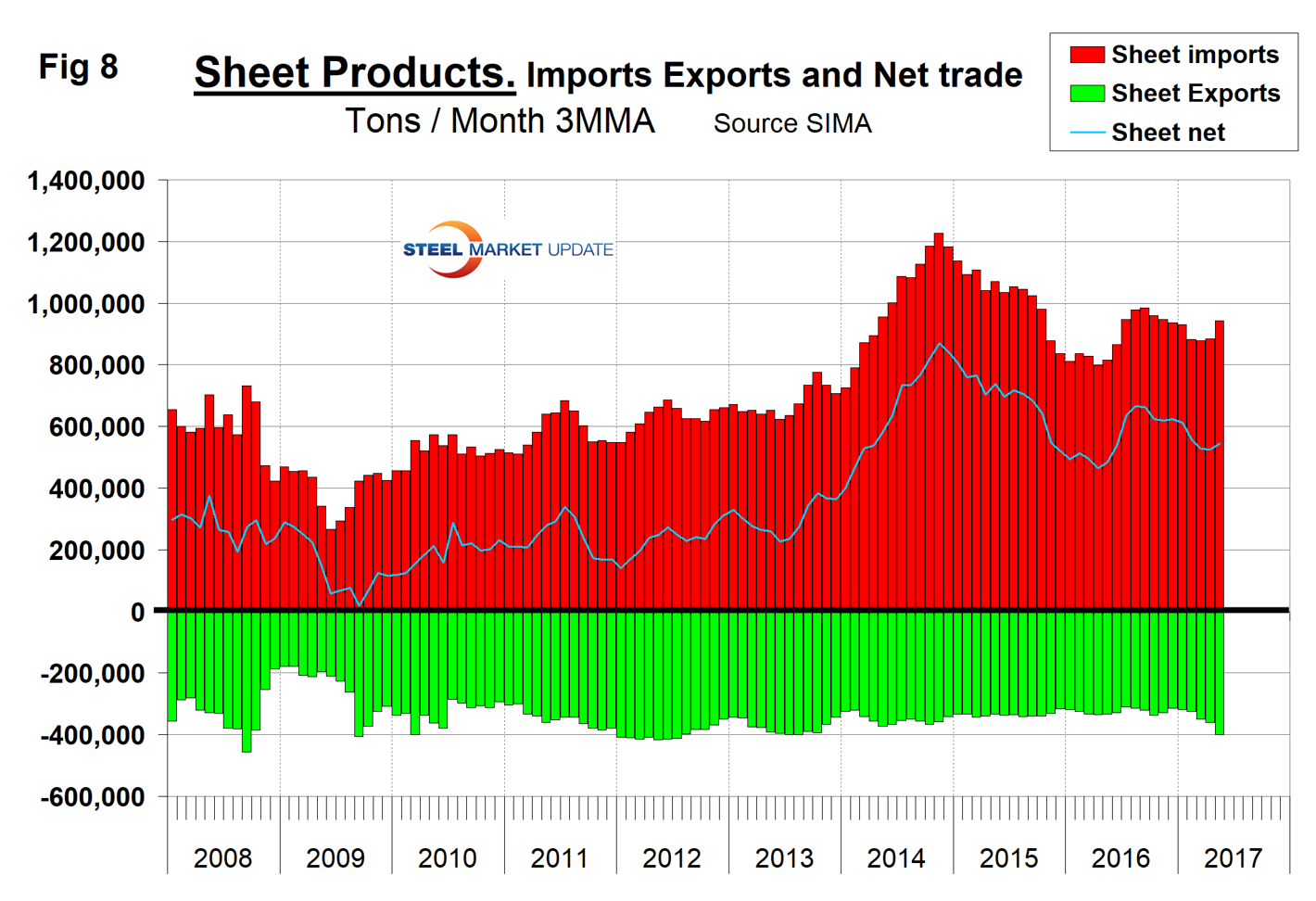
Explanation: SMU publishes several import reports ranging from this very early look using licensed data to the very detailed analysis of final volumes by product, by district of entry and by source nation, which is available on the premium member section of our website. The early look, the latest of which you are reading now, has been based on three-month moving averages (3MMA) using the latest licensed data, either the preliminary or final data for the previous month and final data for earlier months. We recognize that the license data is subject to revisions, but believe that by combining it with earlier months in this way gives a reasonably accurate assessment of volume trends by product as early as possible. We are more interested in direction than we are in absolute volumes at this stage. The main issue with the license data is that the month in which the tonnage arrives is not always the same month in which the license was recorded. In 2014 as a whole, our data showed that the reported licensed tonnage of all carbon and low alloy products was 2.3 percent less than actual receipts, close enough we believe to confidently include licensed data in this current update. The discrepancy declined continuously during the 12-month evaluation as a longer time period was considered.
Statement from the Department of Commerce: The Steel Import Monitoring and Analysis (SIMA) system, under the Department of Commerce, collects and publishes data of steel mill product imports. By design this information provides stakeholders valuable information on steel trade with the United States. This is achieved through two tools: the steel licensing program and the steel import monitor. All steel mill imports into the United States require a license issued by the SIMA office. The SIMA Licensing System is an on-line automatic system for users to register, apply for, and receive licenses in a quick and timely manner. This on-line system allows importers to process imports with minimal effort and added efficiency. In addition to managing the licensing system, SIMA publishes near real-time aggregate data on steel mill imports into the United States. These data incorporate information collected from steel license applications and publicly released Census data. The data are displayed in tables and graphs for users to analyze various levels and changes in steel trade involving the United States. Additionally, SIMA provides data on U.S. steel mill exports, as well as imports and exports of select downstream steel products.

Peter Wright
Read more from Peter WrightLatest in Steel Products Prices North America

Nucor slows HRC price climb with $5/ton increase
After eight weeks of double-digit price increases on hot-rolled (HR) coil, Nucor slowed the price rise this week with an increase of $5 per short ton.

Domestic CRC prices surge ahead of imports
The price spread between stateside-produced CR and imports reached its widest margin in over a year.

Evraz raises plate prices $160/ton
Evraz North America (NA) has followed Nucor and SSAB with a plate price increase of its own: up $160 per short ton (st). The increase was effective immediately for all new orders of carbon, high-strength low-alloy, and normalized and quenched-and-tempered plate products, as well as for hot-rolled coil, the steelmaker said in a letter to […]

Nucor lifts HR coil to $820/ton
Nucor has increased its consumer spot price (CSP) for hot-rolled (HR) coil for a fourth consecutive week.

Nucor pushes HR spot price to $790/ton
Nucor increased its consumer spot price (CSP) for hot-rolled (HR) coil to $790 per short ton (st) on Monday, Feb. 10 – a $15/st bump vs. last week. The Charlotte, N.C.-based company has raised its weekly CSP by $40/st over the past three weeks after maintaining tags at $750/st since Nov. 12, according to SMU’s […]
